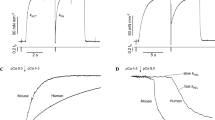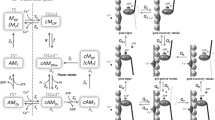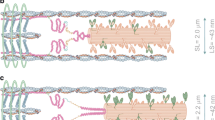Abstract
Fast solution switching techniques in single myofibrils offer the opportunity to dissect and directly examine the sarcomeric mechanisms responsible for force generation and relaxation. The feasibility of this approach is tested here in human cardiac myofibrils isolated from small samples of atrial and ventricular tissue. At sarcomere lengths between 2.0 and 2.3 μm, resting tensions were significantly higher in ventricular than in atrial myofibrils. The rate constant of active tension generation after maximal Ca2+ activation (k ACT) was markedly faster in atrial than in ventricular myofibrils. In both myofibril types k ACT was the same as the rate of tension redevelopment after mechanical perturbations and decreased significantly by decreasing [Ca2+] in the activating solution. Upon sudden Ca2+ removal, active tension fully relaxed. Relaxation kinetics were (1) much faster in atrial than in ventricular myofibrils, (2) unaffected by bepridil, a drug that increases the affinity of troponin for Ca2+, and (3) strongly accelerated by small increases in inorganic phosphate concentration. The results indicate that myofibril tension activation and relaxation rates reflect apparent cross-bridge kinetics and their Ca2+ regulation rather than the rates at which thin filaments are switched on or off by Ca2+ binding or removal. Myofibrils from human hearts retain intact mechanisms for contraction regulation and tension generation and represent a viable experimental model to investigate function and dysfunction of human cardiac sarcomeres.





Similar content being viewed by others
References
Hajjar RJ, Gwathmey JK, Briggs GM, Morgan JP (1988) Differential effect of DPI 201-106 on the sensitivity of the myofilaments to Ca2+ in intact and skinned trabeculae from control and myopathic human hearts. J Clin Invest 82:1578–1584
Morano I, Bletz C, Wojciechowski R, Ruegg JC (1991) Modulation of crossbridge kinetics by myosin isoenzymes in skinned human heart fibers. Circ Res 68:614–618
Zacharzowsky UB, Shah AM, Haase H, Morano I (1999) Inhibition of crossbridge function in the normal human heart by hypoxic endothelial superfusate. Biochem Biophys Res Commun 262:64–67
Mulieri LA, Barnes W, Leavitt BJ, Ittleman FP, LeWinter MM, Alpert NR et al (2002) Alterations of myocardial dynamic stiffness implicating abnormal crossbridge function in human mitral regurgitation heart failure. Circ Res 90:66–72
Narolska NA, van Loon RB, Boontje NM, Zaremba R, Penas SE, Russell J et al (2005) Myocardial contraction is 5-fold more economical in ventricular than in atrial human tissue. Cardiovasc Res 65:221–229
Wolff MR, Buck SH, Stoker SW, Greaser ML, Mentzer RM (1996) Myofibrillar calcium sensitivity of isometric tension is increased in human dilated cardiomyopathies: role of altered beta-adrenergically mediated protein phosphorylation. J Clin Invest 98:167–176
van Der Velden J, Klein LJ, Zaremba R, Boontje NM, Huybregts MA, Stooker W et al (2001) Effects of calcium, inorganic phosphate, and pH on isometric force in single skinned cardiomyocytes from donor and failing human hearts. Circulation 104:1140–1146
Borbely A, van der Velden J, Papp Z, Bronzwaer JGF, Edes I, Stienen GJM et al (2005) Cardiomyocyte stiffness in diastolic heart failure. Circulation 111:774–781
Poggesi C, Tesi C, Stehle R (2005) Sarcomeric determinants of striated muscle relaxation kinetics. Invited Review. Pflügers Arch 449:505–517
Linke WA, Popov VI, Pollack GH (1994) Passive and active tension in single cardiac myofibrils. Biophys J 67:782–792
Colomo F, Piroddi N, Poggesi, C, te Kronnie KG, Tesi C (1997) Active and passive forces of isolated myofibrils from cardiac and fast skeletal muscle of the frog. J Physiol 500:535–548
Stehle R, Krueger M, Pfitzer G (2002) Force kinetics and individual sarcomere dynamics in cardiac myofibrils following rapid Ca2+ changes. Biophys J 83:2152–2161
Sachs F (1999) Practical limits on the maximal speed of solution exchange for patch clamp experiments. Biophys J 77:682–690
Tesi C, Colomo F, Nencini S, Piroddi N, Poggesi, C (2000) The effect of inorganic phosphate on force generation in single myofibrils from rabbit skeletal muscle. Biophys J 78:3081–3092
Tesi C, Piroddi N, Colomo F, Poggesi C (2002) Relaxation kinetics following sudden Ca2+ reduction in single myofibrils from skeletal muscle. Biophys J 83:2142–2151
Cazorla O, Freiburg A, Helmes M, Centner T, McNabb M, Wu Y et al (2000) Differential expression of cardiac titin isoforms and modulation of cellular stiffness. Circ Res 86:59–67
Reiser PJ, Portman MA, Ning XH, Schomisch Moravec C (2001) Human cardiac myosin heavy chain isoforms in fetal and failing adult atria and ventricles. Am J Physiol 280:H1814–H1820
Gordon AM, Homsher E, Regnier M (2000) Regulation of contraction in striated muscle. Physiol Rev 80:853–924
Solaro RJ, Bousquet P, Johnson JD (1986) Stimulation of cardiac myofilament force, ATPase activity and troponin C Ca++ binding by bepridil. J Pharmacol Exp Ther 238:502–507
MacLachlan LK, Reid DG, Mitchell RC, Salter CJ, Smith SJ (1990) Binding of a calcium sensitizer, bepridil, to cardiac troponin C. A fluorescence stopped-flow kinetic, circular dichroism, and proton nuclear magnetic resonance study. J Biol Chem 265:9764–9770
Neagoe C, Kulke M, del Monte F, Gwathmey JK, de Tombe PP, Hajjar RJ et al (2002) Titin isoform switch in ischemic human heart disease. Circulation 106:1333–1341
Nagueh SF, Shah G, Wu Y, Torre-Amione G, King NM, Lahmers S et al (2004) Altered titin expression, myocardial stiffness, and left ventricular function in patients with dilated cardiomyopathy. Circulation 110:155–162
Backx PH, Gao WD, Azan-Backx MD, Marban E (1995) The relationship between contractile force and intracellular [Ca2+] in intact rat cardiac trabeculae. J Gen Physiol 105:1–19
Stehle R, Kruger M, Scherer P, Brixius K, Schwinger RH, Pfitzer G (2002) Isometric force kinetics upon rapid activation and relaxation of mouse, guinea-pig and human heart muscle studied on the subcellular myofibrillar level. Basic Res Cardiol 97(Suppl 1):I127–I135
van der Velden J, Klein LJ, van der Bijl M, Huybregts MAJM, Stooker W, Witkop J et al (1999) Isometric tension development and its calcium sensitivity in skinned myocyte-sized preparations from different regions of the human heart. Cardiovasc Res 42:706–719
Moss RL, Razumova M, Fitzsimmons DP (2004) Myosin cross bridge activation of cardiac thin filaments: implications for myocardial function in health and disease. Circ Res 94:1290–1300
van der Velden J, Papp Z, Boontje NM, de Jong JW, Janssen PML, Hasenfuss G et al (2003) The effect of myosin light chain 2 dephosphorylation on Ca2+-sensitivity of force is enhanced in failing human hearts. Cardiovasc Res 57:505–514
Morano M, Zacharzowski U, Maier M, Lange PE, Alexi-Meskishvili V, Haase H et al (1996) Regulation of human heart contractility by essential myosin light chain isoforms. J Clin Invest 98:467–473
Bottinelli R, Canepari M, Cappelli V, Reggiani C (1995) Maximum speed of shortening and ATPase activity in atrial and ventricular myocardia of hyperthyroid rats. Am J Physiol 269:C785–C790
Buck SH, Konyn PJ, Palermo J, Robbins J, Moss RL (1999) Altered kinetics of contraction of mouse atrial myocytes expressing ventricular myosin regulatory chain. Am J Physiol 276:H1167–H1171
Li Y, Love ML, Putkey JA, Cohen C (2000) Bepridil opens the regulatory N-terminal lobe of cardiac troponin C. Proc Natl Acad Sci USA 97:5140–5145
Brenner B (1988) Effect of Ca2+ on cross bridge turnover kinetics in skinned single rabbit psoas fibers: implication for regulation of muscle contraction. Proc Natl Acad Sci USA 83:3265–3269
Brenner B, Chalovich JM (1999) Kinetics of thin filament activation probed by fluorescence of N-((2-(iodoacetoxy)ethyl)-N-methyl)amino-7-nitrobenz-2-oxa-1, 3-diazole-labeled troponin I incorporated into skinned fibers of rabbit psoas muscle: implications for regulation of muscle contraction. Biophys J 77:2692–2708
Acknowledgements
This work was supported by Telethon–Italy (grant # GGP02428), Ministero Istruzione Università e Ricerca (PRIN2004), and European Union (STREP Project “NORMACOR,” 6th European Framework Program, contract LSH M/CT/2006/018676). The contents of this work are solely the responsibility of the authors and do not necessarily represent an official view of awarding organizations.
Author information
Authors and Affiliations
Corresponding author
Rights and permissions
About this article
Cite this article
Piroddi, N., Belus, A., Scellini, B. et al. Tension generation and relaxation in single myofibrils from human atrial and ventricular myocardium. Pflugers Arch - Eur J Physiol 454, 63–73 (2007). https://doi.org/10.1007/s00424-006-0181-3
Received:
Accepted:
Published:
Issue Date:
DOI: https://doi.org/10.1007/s00424-006-0181-3




